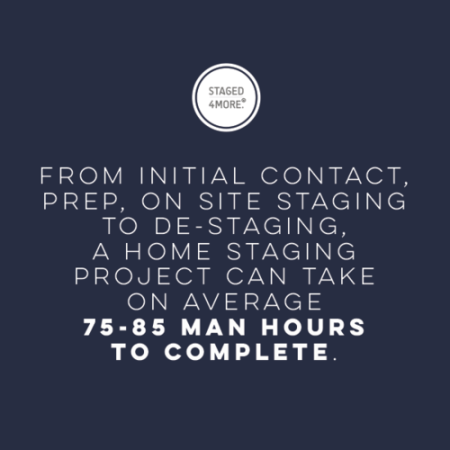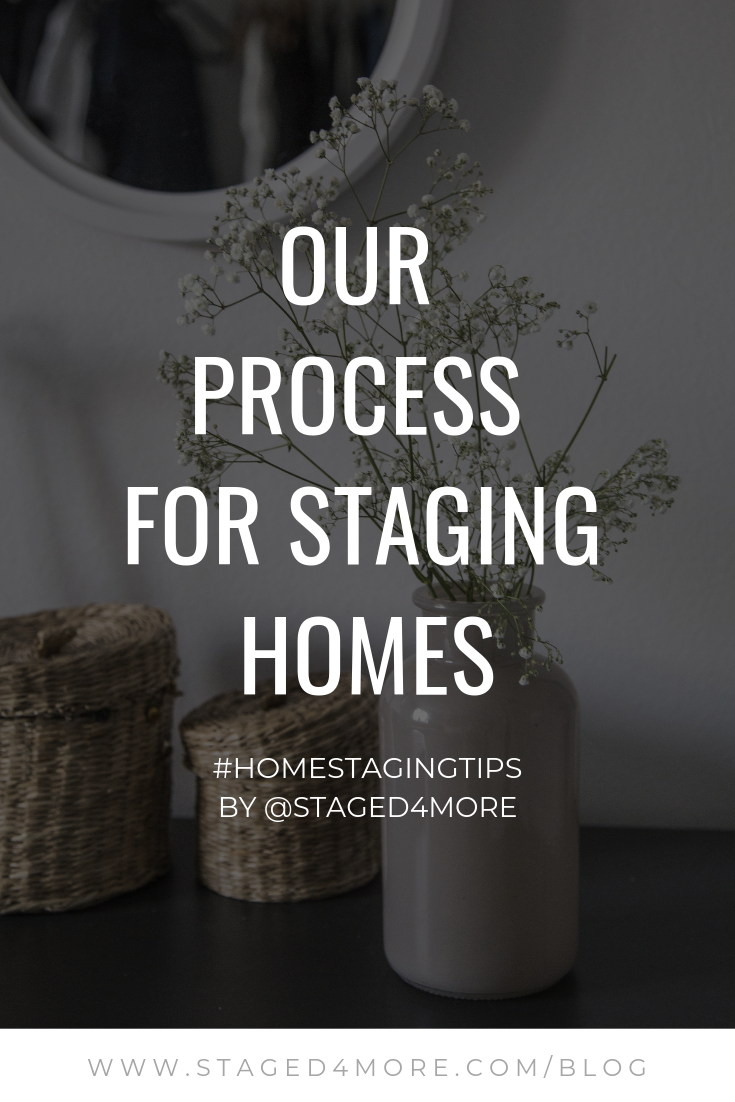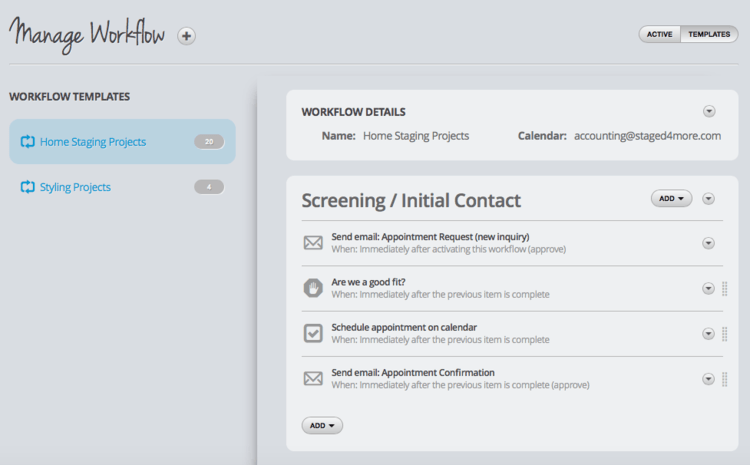Our Process for Staging Homes
Hey there!
I'm Cindy
Founder of Staged4more.
Having been in the home staging industry for more than ten years, we have developed a process to help us pull a house together and create the best results for our clients. Having a process in place is so important. It helps to simplify our decision making and inventory selection, be more efficient with our work load, and break the debate if we butt heads on styling decisions. It is an ever-revolving process and technology like 17hats also helps to keep us on track. Having a system is crucial in running any business.
Today I’m giving you a peek at our process so that you might take away some helpful insights that make working with a home stager or staging your listing less frustrating and more efficient for you.
1. LOGISTICS SUPPORT
I have to mention logistics here because our job is filled with lots of moving pieces, so having a good handle on logistics is important.
We brought on a Project Coordinator and she has been a great addition to the team, helping us with managing logistics, scheduling, and invoices. The main decision behind hiring a Project Coordinator was inspired by my experience working on photo shoots. Having an agent really freed me up from worrying about paperwork and contract negotiations and allowed me to do what I do best on set.
Having gone through that experience, we realized that we were getting bogged down by the day-to-day stuff, and we were distracted from getting the real business done — delivering a great staged home to our clients and passion projects like developing programs about home staging (like our courses).
Having a workflow and templates in 17hats has helped a lot. Our Project Coordinator, who is much better with customer service and logistics, is able to access the system easily and follows through. Because we almost tripled our volume last year, we switched to credit card payments and electronic signatures only to eliminate inefficiency and paperwork.
Having logistics support really helped us to have a smoother onboarding process with new clients which helps to build a better client relationship.
Click on the photo to read our review of 17hats.
2. ON-SITE VISITS & DRAFTING THE PROPOSAL
When a client calls, whether potential or repeat clients, I generally have a brief conversations with him/her to get a sense of the scope of the project. This is also a pre-screening process to see if we would be a good fit with their project.
Once the initial phone conversation has happened, our Project Coordinator schedules / confirms an on-site visit with the clients. On-site visits are crucial because it gives us a great idea on what the neighborhood is like, who the target buyers may be, and what finishes and color schemes we will use for staging.
This process can also get time-consuming on the back end, even though it may only look like the two of us had spent 15-30 minutes on site writing notes & taking photos for planning purposes. This is also why we decided to start billing for on-site visits, because typically with Bay Area traffic, it takes about an hour or more to get to the site and back, not to mention we usually meet for another 15-30 minutes to discuss the design plan for the property. So overall, drafting a proposal can take 2-3 hours.
3. IN STUDIO: DESIGN & PREP
Before we prep, we sit down together again and go through our notes & photos we took during our site visit. We would go through the photos room by room and double-check the proposal to see what we would need to pull from inventory to work with the home’s existing colors, finishes, and architecture details. We print out our prep list and off we go.
Much like our actual staging process, we work from big to small. We normally pick the largest pieces first, like sofa, coffee table, rug, accent chairs, etc. and work our way down. Pulling and packing accessories take the most time.
Usually, our prep process takes 4-6 hours with both of us working. I’d pull accessories, decorative items, floral and then we pull lighting, artwork and then write up the locations of the big pieces that are going to get packed first. (This is why we ask clients for at least a 3-day notice before scheduling the installation date, because we need to schedule time in for prep.)
4. STAGING DAY!
Our movers usually arrive at 8am, but we generally show up at 7am to make sure we have everything ready before the job. Typically, load-out takes about 1-1.5 hours, depending on the size of the job. With traffic, we generally arrive on site between 10-11am. Once we arrive at the house, it’s a flurry of activities.
Our movers have been with us for a long time now and they know roughly where we want to drop furniture. They also know that they will need to assemble the beds, furniture, and move all the bins to the kitchen. Once bins are out, I start unpacking everything, so we can visually shop decor pieces and accessories to style each room. Like the way we pull inventory initially, we drop the big pieces first and then work on accessories and artwork.
Before we leave, we do an once-over, to make sure every corner is covered and we are happy with the overall staging. More importantly, the home looks ready to photograph before we leave.
5. MARKETING
I’ll be the first to admit that we are usually not as diligent as we should be on this!
But I normally try to whip out some sort of blog posts or at least post on Instagram about it (at some point). Social media is important nowadays, since we actually see an increase in web traffic and sometimes even lead to other projects when we share our work.
6. WRAP & PACK

Once the home is sold and contingencies are removed (until contingencies are removed, your home sale is not yet a done deal. The deal can still fall apart.), our Project Coordinator schedules a date for de-staging. We will go to the house at 7-7:30am and start packing. Movers show up at 8am to move everything out. Generally depending on the size of the project, on-site removal can take 2-3 hours and in-studio, another 1-2 hours. After movers leave, we unpack the bins and restock everything in our warehouse.
All in all, from initial contact, prep, on-site staging to de-staging, pack and wrap, a home staging project can take about 75-85 man hours on average to complete. Staging the home right can be a time-consuming process. One that has a lot of invisible pieces that are unseen and therefore undermined by our clients.
It is a lot of hard work. To have a fully stock 5800+ square feet prop house takes time to cultivate and develop. We also have to constantly be on our toes with trends and new inventory by frequently visiting vendors and furniture shows. But all is well worth it when we can pull something awesome together for our clients.
There you have it! That’s our staging process in a nutshell!
If you are a home stager reading this post, what does your home staging process look like? If you are a real estate agent or seller, are you surprised by what we go through to successfully stage a house? I’d love to hear from you!
What Are You Looking For?
Company
About
Join the School
Events
Podcast
Home Stager Directory
International Home Staging Awards
StagerCon 2023
Subscribe to our newsletter
Contact
Student Log-In
Teach on Staged4more
Terms & Privacy Policy
Affiliate Disclosure
Contribute & Ads
Sponsorship
Join Us
FAQs
Become an Ambassador
Contact
Website Design by Local Creative
© 2025 Staged4more. All Rights Reserved

